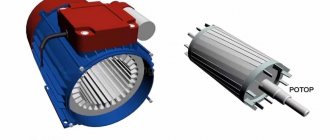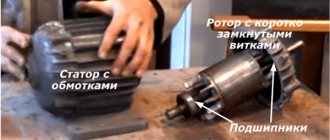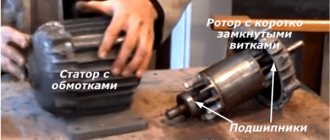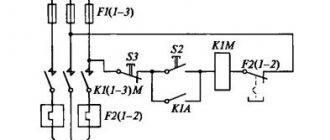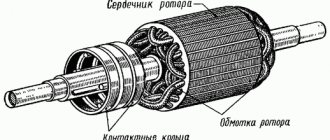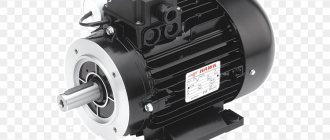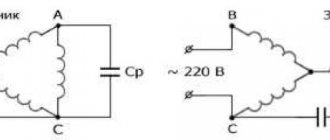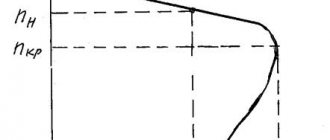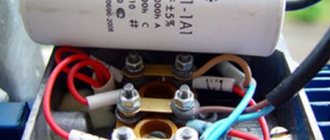Switching to the desired voltage
First we need to make sure that our engine has the necessary parameters. They are written on a tag attached to his side. It should indicate that one of the parameters is 220V. Next, let's look at the connection of the windings. It is worth remembering this pattern of the circuit: star - for lower voltage, triangle - for higher voltage. What does this mean?
Voltage increase
Let's say the tag says: Δ/Ỵ220/380. This means that we need a delta connection, since most often the default connection is 380 volts. How to do it? If the electric motor in the burner has a terminal box, then it is not difficult. There are jumpers there, and all you need to do is switch them to the desired position.
But what if there are just three wires? Then you will have to disassemble the device. On the stator you need to find three ends that are soldered together. This is a star connection. The wires need to be disconnected and connected in a triangle.
In this situation this does not cause any difficulties. The main thing to remember is that there is a beginning and an end to the coils. For example, let’s take as a starting point the ends that were brought out into the boron of the electric motor. This means that what is soldered is the ends. Now it’s important not to get confused.
We connect like this: we connect the beginning of one coil to the end of the other, and so on.
As you can see, the scheme is simple. Now the engine, which was connected for 380, can be connected to a 220 volt network.
Voltage reduction
Let's say the tag says: Δ/Ỵ 127/220. This means a star connection is required. Again, if there is a terminal box, then everything is fine. What if not, and our electric motor is turned on in a triangle? And if the ends are not signed, then how to connect them correctly? After all, here it is also important to know where the coil winding begins and where the end is. There are some ways to solve this problem.
First, let's move all six ends apart and use an ohmmeter to find the stator coils themselves.
Let's take adhesive tape, duct tape, whatever else we have, and mark them. It will come in handy now, and maybe someday in the future.
We take a regular battery and connect it to ends a1-a2. We connect an ohmmeter to the other two ends (c1-c2).
At the moment the contact with the battery is broken, the arrow of the device will swing to one side. Let's remember where it swung and turn on the device to ends c1-c2, without changing the polarity of the battery. Let's do it all over again.
If the arrow deviates in the other direction, then we swap the wires: we mark c1 as c2, and c2 as c1. The point is that the deviation is the same.
Now we connect the battery, observing polarity, to ends c1-c2, and the ohmmeter to a1-a2.
We ensure that the needle deflection on any reel is the same. Let's double check again. Now one bundle of wires (for example, with the number 1) will be the beginning, and the other will be the end.
We take three ends, for example, a2, b2, c2, and connect them together and isolate them. This will be a star connection. As an option, we can output them directly to the terminal block and label them. We paste the connection diagram onto the lid (or draw it with a marker).
Switching triangle - star done. You can connect to the network and work.
4Out80v2 16uhl4 connection diagram
Washing machines, over time, fail or become obsolete. As a rule, the basis of any washing machine is its electric motor, which can be used even after disassembling the washing machine for spare parts.
The power of such engines, as a rule, is not less than 200 W, and sometimes much more; the shaft speed can reach up to 11,000 rpm, which may well be suitable for using such an engine for household or small industrial needs.
Here are just a few ideas for the successful use of an electric motor from a washing machine:
- A sharpening (“emery”) machine for sharpening knives and small household and garden tools. The engine is installed on a solid base, and a whetstone or emery wheel is attached to the shaft.
- Vibrating table for the production of decorative tiles, paving slabs or other concrete products where it is necessary to compact the solution and remove air bubbles from it. Or perhaps you are engaged in the production of silicone molds, for this you also need a vibrating table.
- Vibrator for concrete shrinkage. Homemade designs, which are abundant on the Internet, can easily be implemented using a small motor from a washing machine.
- Concrete mixer. Such an engine is quite suitable for a small concrete mixer. After a little modification, you can use a standard tank from a washing machine.
- Hand construction mixer. Using this mixer you can mix plaster mixtures, tile adhesive, and concrete.
- Lawnmower. An excellent option in terms of power and size for a lawn mower on wheels. Any ready-made platform on 4 wheels with a motor mounted in the center with direct drive to the “knives” that will be located below will do. The height of the lawn can be adjusted by planting, for example by raising or lowering the wheels on hinges in relation to the main platform.
- Mill for grinding grass and hay or grain. This is especially true for farmers and people raising poultry and other livestock. You can also prepare feed for the winter.
Single phase
These are single phase AC capacitor machines. They have two windings, of which, after starting, only one of them works. Such engines have their own characteristics. Let's look at them using the example of the ABE-071-4C model. In another way, they are also called split-phase asynchronous motors. They have another auxiliary winding wound on the stator, offset relative to the main one. Starting is carried out using a phase-shifting capacitor.
Diagram of a single-phase asynchronous motor
From the diagram it can be seen that AVE electric machines differ from their three-phase counterparts, as well as from single-phase collector units.
Always carefully read what is written on the tag! The fact that three wires are output does not mean at all that it is for a 380 V connection. Just burn the good stuff!
Asynchronous motor device
The power of this engine depends on the design features and can vary from 5 to 10 kW. Its rotor is a short-circuited winding - aluminum or copper rods that are closed at the ends.
As a rule, a single-phase asynchronous electric motor is equipped with two windings offset by 90° relative to each other. In this case, the main (working) one occupies a significant part of the grooves, and the auxiliary (starting) one occupies the remaining part. The single-phase asynchronous electric motor received its name only because it has only one working winding.
Basic parameters of the 90L-2 electric motor.
| Parameter | Meaning | Explanations |
| Nominal torque (C n), N*m | 7.49 | The rated torque of an electric motor depends on power and speed. It is calculated as the product of the force and the radius of the shaft. |
| Ratio of starting torque (C s) to nominal | 2.9 | Starting torque is the torque that the engine must develop in order to get off the ground and develop the installed power. |
| Ratio of maximum torque (C max) to rated motor torque | 3 | The maximum torque produced by a motor of a certain rated power at a certain speed. Maximum torque also represents the amount of resistance at which the engine stops. |
| Rated current In, A | 4.75 | The current consumed by a motor when rated voltage is applied to achieve rated power. For another applied voltage, the current consumption is calculated proportional to that voltage. |
| Ratio of motor starting current I s to rated current | 5.2 | |
| Noise, dB | 72 | |
| Electric motor weight, kg | 14 |
4Out80v2 16uhl4 connection diagram
For repairs and other technical issues, click here. Repair of household and office equipment.
Connecting the Vyatka motor - automatic. Krasnodar Kuban.
The electric motor from the Vyatka washing machine is an automatic machine designed to operate in a single-phase network. Consists of two working and two reverse coils. Together with capacitors, they create the direction of shaft rotation.
Vyatka had different modifications of engines, but their characteristics were approximately the same. All of them have two reverse rotation speeds. 2200 rpm min. for spin and 450 rpm. min per wash cycle.
Features of using a magnetic starter
The control part of the device has several pairs of contacts on which the relay automation circuit is assembled. One of them is always normally closed, and the second is always normally open.
The “Start” button has a normally open contact, while the “Stop” button has a normally closed element.
When connecting the device in question, several types of connections are made.
Single-phase motor connection diagram
The phase, along with the input terminal, is also connected to the contact input of the “Stop” button, and the zero is connected to the input terminal of the coil, which ensures that control current flows through it.
The active contact of the “Start” button when the engine is running is bypassed by a similar element of the coil. To form this circuit, two additional connections are made, the diagram of which is shown in the figure above:
- the output of the working contact of the “Stop” button is connected in parallel with the output contacts of the “Start” button and the input of the control coil;
- the output of the normally open contact of the control coil is connected in parallel to its output terminal and to the input of the working contact of the “Start” button.
Functionality check
How to check engine performance by visual inspection?
The following are defects that indicate possible problems with the engine; they could be caused by improper operation or overload:
- Broken support
or mounting gaps. - in the middle of the engine
has darkened (indicates overheating). - through cracks
in the housing.
To check the performance of the engine, you should first turn it on for 1 minute, and then let it run for about 15 minutes.
If after this the engine is hot, then:
- Perhaps
the bearings are dirty, jammed, or simply worn out. - The reason
may be that the capacitor capacitance is too high.
Disconnect the capacitor and start the motor manually: if it stops heating, you need to reduce the capacitor capacitance.
Principle of operation
Flowing through the main winding creates a periodically changing magnetic field. It consists of two circles of the same amplitude, the rotation of which occurs towards each other.
2. Starters, for example, are divided by a value from 1 to 7, and the higher this indicator, the greater the current the contact system of these devices can withstand.
- 10A - 1.
- 25A - 2.
- 40A - 3.
- 63A - 4.
- 80A - 5.
- 125A - 6.
- 200A - 7.
3. After the starter size has been determined, you need to pay attention to the control coil. It can be 36B, 380B and 220B. It is advisable to focus on the last option.
5. The “Stop - Start” buttons are connected. They are powered from the input power contacts of the starter. For example, a phase is connected to the “Stop” button of a closed contact, then from it it goes to the start button of an open contact, and from the contact of the “Start” button to one of the contacts of the magnetic starter coil.
6. “Zero” is connected to the second terminal of the starter. To fix the on position of the magnetic starter, it is necessary to bypass the start button of the closed contact to the contact block of the starter, which supplies power from the “Stop” button to the coil.
Single-phase motors are used for various household appliances. They are found in pumps and washing machines. If necessary, you can repair and connect such a unit with your own hands and check its winding. To connect a single-phase electric motor, you need to select a circuit and then follow the process exactly.
What is a single-phase motor? In this case, the current creates a magnetic pulsating field with different amplitudes during operation. This is what makes the resulting torque equal to zero when starting the motor; without a special device it simply will not start rotating. If the rotor is set in motion in one direction or another (that is, its rotation is observed), then one moment begins to prevail over the other, the motor shaft continues to move.
The motor is started due to the appearance of a magnetic rotating field. The number of windings is two, the rotor is squirrel-cage. Basically, single-phase motors are used for low-power devices, for example, for household appliances, for fans, pumps, for drilling water wells.
